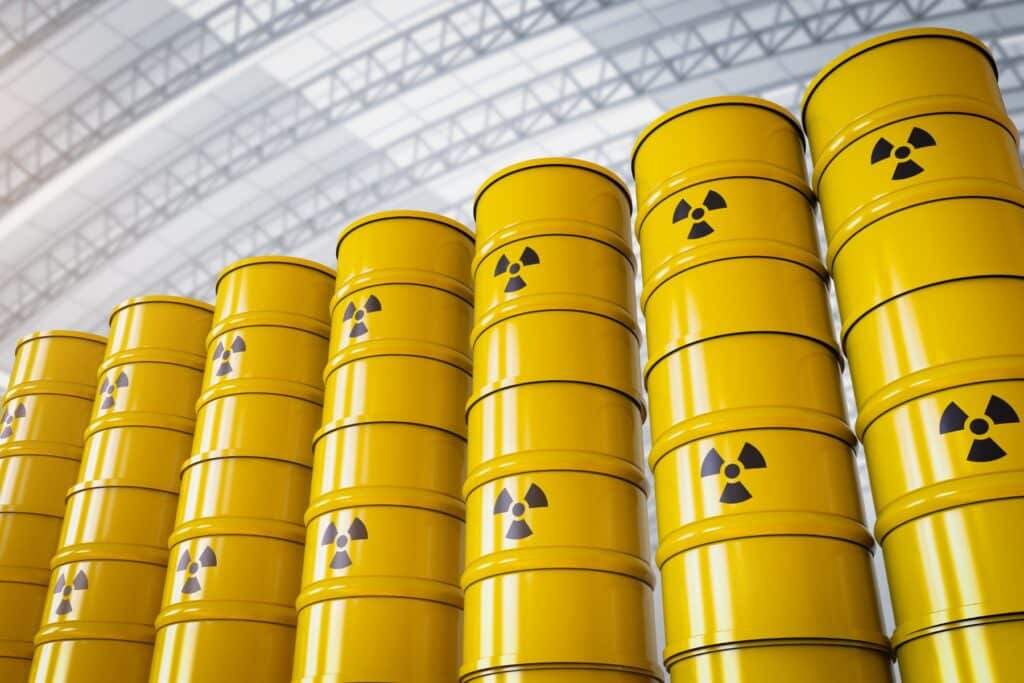Manufacturer’s Guide to Disposal of Hazardous Waste

The Environmental Protection Agency (EPA) defines hazardous waste as waste with properties that make it dangerous or capable of having a harmful effect on human health or the environment. It can be generated from various sources, many times produced by the chemical manufacturing industry. In order to be classified as a hazardous waste, it must first be considered a solid waste. Solid waste includes non-sharp items contaminated with bodily fluids or biological material, such as surgical gloves or towels. The Environmental Protection Agency (EPA) passed the Resource and Recovery Act (RCRA) in 1976 to regulate hazardous waste. The purpose of this act was to give the EPA the power to control hazardous waste from the generation, transportation, treatment, storage, and disposal of hazardous waste.
Basic chemical manufacturing, petroleum and coal product manufacturing, and waste treatment and disposal created the most hazardous waste in 2019, according to the EPA. Basic chemical manufacturing creates the most hazardous waste, per the EPA. The EPA reported 20.1 million metric tonnes of hazardous waste from this industry in 2019. This industry produces hazardous trash such as spent solvents, distillation leftovers, organic wastes like benzene, and metals like barium and silver. Petroleum and coal product manufacturing created 5.3 million metric tonnes of hazardous waste in 2019. This industry produces hazardous waste such as wasted solvents, used catalysts, tank sludge, metals like chromium, lead, and selenium, and organics like benzene, toluene, and xylene. Garbage Treatment and Disposal produces 3.3 million metric tonnes of hazardous garbage and several chemical products.
Types of Hazardous Waste
Before going into the proper way of disposing of hazardous waste, it is important to understand the two different types of hazardous waste, listed waste and characteristic waste. Listed waste is waste that appears on one of four lists published in the Code of Federal Regulations. As of now, there are over 500 wastes that are listed. However, when managed properly, some listed wastes become acutely hazardous due to their extreme danger.Examples of this include wastes generated from pesticides that can be fatal to humans, even in small amounts. The Environmental Protection Agency has four different classifications of hazardous waste the F list, K List, P list, and U list. Listed below are the various types of waste each list includes.
The F List
Depending on the manufacturing or industrial operation type, one can divide the F list wastes into seven groups. The seven different groups are listed below.
1.Spent solvent wastes
2.Electroplating and other metal finishing wastes
3.Dioxin-bearing wastes
4.Chlorinated aliphatic hydrocarbons production
5.Wood preserving wastes
6.Petroleum refinery wastewater treatment sludges
7.Multisource leachate
The F-list identifies all wastes from manufacturing and industrial processes, regardless of where they come from.
The K-List
K-list hazardous waste comes from specific sources, but F-list hazardous waste does not. Manufacturing waste is considered source-specific waste. To be characterized as a K-list hazardous waste, it must fit into one of the thirteen categories listed below.
1.Wood preservation
2.Organic chemicals manufacturing
3.Pesticides manufacturing
4.Petroleum refining
5.Veterinary pharmaceuticals manufacturing,
6.Inorganic pigment manufacturing,
7.Inorganic chemicals manufacturing,
8.Explosives manufacturing,
9.Iron and steel production,
10.Primary aluminum production,
11.Secondary lead processing,
12.Ink formulation, and
13.Coking (processing of coal to produce coke)
The EPA assigns codes to both F-list and K-list wastes. You can find these codes on the EPA website. They classify the wastes depending on if they contain any of the following: Toxic Waste (T), Acute Hazardous Waste (H), Ignitable Waste (I), Corrosive Waste (C), Reactive Waste (R), Toxicity Characteristic Waste (E). Toxic and Acute Hazardous waste apply to wastes whose constituents are considered a threat to human and environmental health. The Environmental Protection Agency (EPA) lists wastes as hazardous if they exhibit one of the four characteristics of hazardous waste: ignitability, corrosivity, reactivity, or toxicity.
The P-List and U-List
The Environmental Protection Agency (EPA) lists commercial chemical products on the P and U lists if they do not consume or recycle hazardous waste. This can include commercial chemical products, off-specification species, container residues, and spill residues. P-list or U-list will include hazardous waste if it meets the following criteria:
1.The waste must contain one of the chemicals listed on the P-list or U-list
2.The chemical in the waste must be unused
3.The chemical in the waste must be in the form of a commercial chemical product
The P-list identifies acute hazardous wastes from discarded commercial chemical produces and has roughly 250 different types of chemicals that are considered hazardous. The U-list has over roughly 550 different types of chemicals that are considered hazardous.
Characteristic Wastes
The second type of hazardous waste is characteristic waste which describes waste that does not appear on one of the hazardous waste lists but is still considered hazardous. Contrary to listed wastes, a hazardous waste characteristic is a property, when present, indicates that the waste poses a sufficient threat to merit regulation as hazardous. Listed below are the four characteristics that identify with waste.
Ignitability
The first characteristic is waste, which is hazardous due to the ignitability of the property. This includes any waste that is flammable and can create fires. Examples are paints and certain degreasers and solvents. The three ways to test the ignitability of waste include the Pensky-Martens Closed-Cup Method, the Setaflash Closed-Cup Method, and the Ignitability of Solids method.
Corrosivity
The second characteristic is waste that is hazardous due to the corrosivity of the waste. This includes any waste, typically acids, and bases, that can rust and decompose and has the ability to melt through metals. Corrosive waste can corrode metals or has a very high or low pH level. Examples of this waste include rust removers, acid or alkaline cleaning fluids, and battery acid. The only way to test the corrosivity towards steel is the Corrosivity Towards Steel method.
Reactivity
The third characteristic is waste that is hazardous due to the reactivity of the waste. This includes any waste that is unstable and explodes or produces toxic fumes, gasses, and vapors when mixed with water or under other conditions such as heat or pressure. Examples of this waste are certain cyanides or sulfide-bearing wastes. There are no ways to test reactivity in a waste.
Toxicity
The fourth and final characteristic is waste that is a hazardous waste due to the toxicity of the waste that is harmful when ingested or absorbed, or it leaches toxic chemicals into the soil or groundwater when disposed of on land. Examples include wastes that contain high concentrations of heavy metals, such as cadmium, lead, or mercury. Toxicity Characteristic Leaching Procedure (TLCP) can test this.
Universal Wastes
Universal Wastes are another classification for hazardous wastes. These types of wastes include bulbs, mercury-containing equipment, pesticides, and batteries. Universal wastes are more commonly produced and often are termed “dangerous goods.” There are nine classifications of these wastes that are listed below.
1: Explosives
2: Gasses
3: Flammable Liquids
4: Flammable Solids or Substances
5: Oxidizing Substances and Organic Peroxides
6: Toxic and Infectious Substances
7: Radioactive
8: Corrosive Substances
Class 9: Miscellaneous Dangerous Substances and Articles
Mixed Wastes
Mixed wastes are wastes that contain both hazardous and radioactive components. Due to this, the treatment and disposal of mixed wastes may be different. The EPA regulates the hazardous component of mixed waste under RCRA. Department of Energy (DOE), or the Nuclear Regulatory Commission (NRC), regulates the radioactive component of the mixed waste. The Mixed Waste Rule enforced by the EPA increased the flexibility of generators and facilities that manage low-level mixed waste (LLMW) and naturally occurring and/or accelerator-produced radioactive material (NARM) containing hazardous waste by exempting these wastes from RCRA storage and treatment requirements. To learn more about the storage, treatment, and disposal of mixed wastes, click here.
Categories of Hazardous Waste Generators
The amount of waste you produce determines the regulations that apply to that generator. There are three categories of hazardous waste generators: Very Small Quantity Generators (VSQGs), Small Quantity Generators (SQGs), and Large Quantity Generators (LQGs). Listed below are the definition of each generator and the specific regulations that apply to each generator, according to the EPA.
Very Small Quantity Generators (VSQGs)
Very Small Quantity Generators (VSQGs) generate 100 kilograms per month of hazardous waste or one kilogram or less per month of acutely hazardous waste. Requirements for VSQGs include:
1.VSQGs must identify all the hazardous waste generated.
2.VSQGs may not accumulate more than 1,000 kilograms of hazardous waste at any time.
3.VSQGs must ensure to deliver of hazardous waste to a person or facility that is authorized to manage it.
Small Quantity Generators (SQGs)
Small Quantity Generators (SQGs) generate more than 100 kilograms but less than 1,000 kilograms of hazardous waste per month. Major requirements for SQGs include:
1.SQGs may accumulate hazardous waste on-site for 180 days without a permit (or 270 days if shipping a distance greater than 200 miles).
2.The quantity of hazardous on-site waste must never exceed 6,000 kilograms.
3.SQGs must comply with the hazardous waste manifest requirements and the pre-transport requirements.
4.SQGs must manage hazardous waste in tanks or containers subject to the requirements found at 40 CFR sections.
5.SQGs must comply with the preparedness and prevention requirements at 40 CFR and the land disposal restriction requirements.
6.There must always be at least one employee available to respond to an emergency. This employee is the emergency coordinator responsible for coordinating all emergency response measures. SQGs are not required to have detailed, written contingency plans.
Large Quantity Generators (LQGs)
Large Quantity Generators (LQGs) generate 1,000 kilograms per month or more of hazardous waste or more than one kilogram per month of acutely hazardous waste. Major requirements for LQGs include:
1.LQGs may only accumulate waste on-site for 90 days. Certain exceptions apply.
2.LQGs do not have a limit on the amount of hazardous waste accumulated on-site.
3.Hazardous waste generated must be managed in tanks, containers, drip pads, or containment buildings subject to the requirements found in 40 CFR sections 262.17(a)(1)-(4) and, specifically for drip pads and containment buildings,
4.LQGs must comply with the hazardous waste manifest requirements and the pre-transport requirements.
5.LQGs must comply with the preparedness, prevention, and emergency procedure requirements and the land disposal restriction requirements.
6.LQGs must submit a biennial hazardous waste report.

How to Dispose of Hazardous Waste
After understanding the different types and classifications of hazardous waste, it is important to know how to properly dispose of hazardous waste. When sorting the hazardous waste at your manufacturing facility for disposal, it is important to identify which waste is hazardous and which is not. There are various ways to dispose of hazardous wastes safely:
1. Recycling – Some waste materials become raw materials and are able to be used for other processes to use, reuse, or reclaim. Common materials to reclaim are solvents or metals, such as acetone and lead.
2.Incineration– this is the process of burning hazardous materials at high temperatures to destroy the contaminants. Types of hazardous waste to incarnate are all materials, including soil, sludge liquids, and gasses. However, incineration does not destroy metals such as lead and chromium. Incinerating hazardous waste significantly reduces the amount of waste to dispose of in a landfill. Incineration is a quicker cleanup approach that helps prevent immediate harm to people and the environment.
3.Treatment– There are a number of biological, thermal, and chemical processes to apply to hazardous waste to neutralize or destroy them. An example of this method is chemicals or microorganisms that can remove hydrocarbons from water that contaminates.
4.Land disposal– Certain hazardous wastes buries in landfills. Landfills minimize the possibility of hazardous waste leakage into the environment. Federal and state regulations mandate these materials shall pretreat before they dispose of in a landfill. Land treatment units use naturally occurring soil microbes and sunlight to treat hazardous waste. There are various EPA design standards landfills must comply with, and find on the EPA website.
If the waste is ignitable, corrosive, reactive, or toxic it is hazardous. These types of waste should be in a waterproof container that seals tightly. Label containers with the type of waste inside. The container has to be able to safely withstand storage, collection, and transport. No more than five gallons of hazardous waste should accumulate at a time. A registered, authorized waste carrier regularly collect and properly dispose of it.
Tips to Manage Your Waste Better
The cheapest and easiest way of managing your waste is to note to generate it in the first place. It is possible to decrease the amount of hazardous waste your business generates by learning what the EPA calls “good housekeeping” habits. These are procedures that aim to save businesses money and prevent accidents and waste. Listed below are the EPA’s four simple practices to enforce at your business.
(1) Avoid Mixing Waste
It is important not to combine non-hazardous waste with hazardous waste. If that does happen, the whole batch becomes hazardous. It can also make recycling waste harder and sometimes impossible. An example of this can be putting non-hazardous cleaning agents in a container of used hazardous solvents.
(2) Change Materials and Processes
An easy way for businesses to save money and increase efficiency is to replace a material or process with another strategy that reduces the amount of waste generated. An example of this is to use a plastic blast media for paint stripping of metal parts instead of using a conventional solvent to strip the paint.
(3) Recycle and Reuse Manufacturing Materials
Many times, businesses will put useful components back into productive use instead of disposing of them. This includes items such as oil, solvents, acids, and metals that are commonly recycled and reused. To help minimize waste, businesses should use fewer solvents that are not as toxic or switch to a detergent solution. In some cases, detergents can actually outperform solvents when cleaning industrial parts while also reducing costs.
(4) Safely Store Hazardous Products and Containers
You should prevent any waste spillage or leakage to avoid producing more hazardous waste. The best way to avoid these issues is to store hazardous waste containers in secure areas and regularly inspect them for leaks. If leaks or spills were to spill, all the cleaning materials would become hazardous waste.
How Much Does it Cost to Dispose of Hazardous Waste
State-specific hazardous waste disposal costs vary. The type of hazardous waste also matters. Hiring a garbage removal firm and paying their costs is the best approach to disposing of hazardous material. Most garbage disposal providers will give your firm red bags for hazardous waste and pick them up to take them to a treatment facility. On-site hazardous waste disposal takes longer and raises the danger of violating Environmental Protection Agency (EPA) rules, which can lead to significant penalties and legal action. Location, type, volume, and pick-up frequency affect garbage disposal firm costs. MedPro Disposal saves the average client 30% on trash disposal. We dispose of medical and hazardous trash in 48 states. MedPro Disposal will increase garbage pickup frequency to keep your business compliant with the new laws. MedPro makes trash disposal easier and cheaper! Click here to understand how MedPro may assist your business.
References:
https://leadlab.com/what-are-the-4-types-of-hazardous-waste/
https://emsllcusa.com/proper-disposal-of-hazardous-waste-in-industrial-manufacturing/
https://rcrapublic.epa.gov/rcra-public-web/action/posts/2
https://www.epa.gov/hwgenerators/categories-hazardous-waste-generators
https://www.epa.gov/hw/defining-hazardous-waste-listed-characteristic-and-mixed-radiological-wastes
https://rcrapublic.epa.gov/rcra-public-web/action/posts/2
https://www.epa.gov/sites/default/files/2015-04/documents/a_citizens_guide_to_incineration.pdf
https://archive.epa.gov/epawaste/hazard/web/html/index-32.html
https://www.epa.gov/hwpermitting/hazardous-waste-management-facilities-and-units#:~:text=Treatment%20%E2%80%93%20Using%20various%20processes%2C%20such,the%20amount%20of%20hazardous%20waste.






